#chnpp
Text
The liquidators (and a journalist) of Chernobyl: some of my favourite lesser known pictures
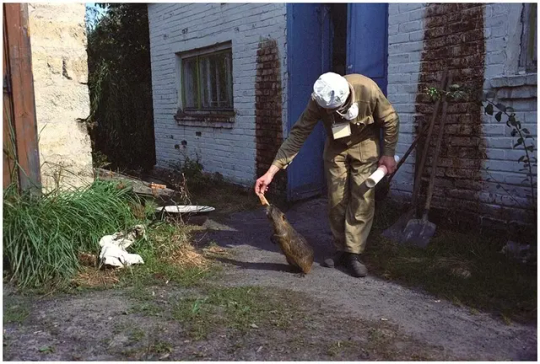


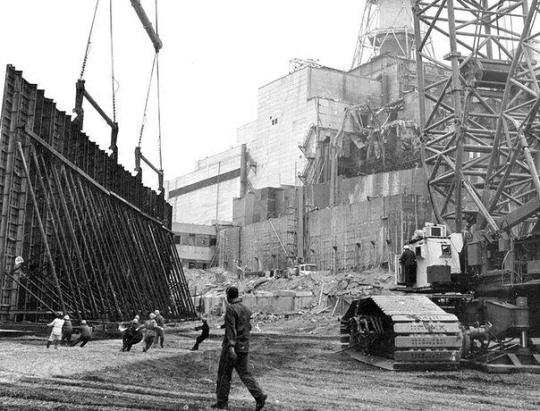

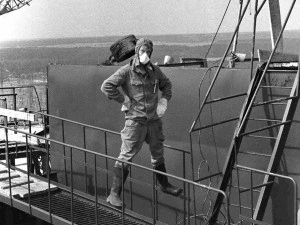
#the first is NOT A BEAVER. i know that it looks like a beaver but this is a nutria (coypu) <awful name. nutria for the win#i have some more... casually posed for photos of the liquidators which are also quite delightful#file: special interest: chernobyl#chernobyl#26th april 1986#nuclear disaster#pripyat#liquidators#чернобыль#chornobyl#soviet union#chnpp#nuclear power plant
23 notes
·
View notes
Text
The Search for the Fuel: The Elephant’s Foot

From the first days of the accident, locating and monitoring the 190 tons of nuclear fuel that had been in the fourth reactor at the time of the explosion was a top priority for the commission overseeing the cleanup. They wanted to ensure that no further disasters would unfold at Chernobyl; with the Soviet Union's international prestige already significantly battered, it was critical that they felt in control of the situation once more. After the initial plume of radionuclides from the burning reactor declined significantly in the early days of May 1986, it was established by the scientists assisting the Commission that the nuclear fuel had three distinct hazards that it could present. These were a radioactive hazard, a nuclear hazard, and a thermal hazard.
Perhaps the most obvious, the radioactive hazard was that of the aforementioned radioactive cloud rising from reactor 4. Although it had decreased significantly, it was still a danger and could potentially flare up again unless measures were taken to prevent it.
The nuclear hazard was the fear of a new uncontrolled nuclear chain reaction like the one that had initially destroyed the reactor. The state of the core was unknown at this time, and scientists had to determine if any of the reactor assembly was still in place and if it or any other mass of fuel had the necessary elements to sustain another catastrophic reaction. Basically, it was a possibility that the fuel could gather in such a way that a new nuclear chain reaction would start.
Finally, the thermal hazard was that of the hot nuclear fuel melting through the concrete of the unit block and into the Earth below. This is known as the “China Syndrome” after a movie of the same name. It was also feared at the time that the fuel could melt down into the bubbler tanks below the reactor, which stored a large reservoir of cooling water, and cause a significant steam explosion. This was the main concern of the government commission and the most effort was put in place to reduce this hazard first.
Having established the potential dangers of the fuel the Commission wanted absolute assurance that the hazard was not an immediate threat to the safety of the workers at Chernobyl and the world at large.
This undertaking was assigned to the team of experts assembled by the Kurchatov Institute, a scientific institute for the study of nuclear physics. It was established early on that most fuel was somewhere within the ruins of the fourth unit, since very little was ejected by the explosion. The building itself was enormous, with winding passages known only to those who worked for years in its labyrinthine walls.
Below: A schematic diagram of the fourth unit block seen from the west. The dimensions of the building are marked in meters. Note the enormous region of rooms located below the reactor core (Closed Reactor Space on this diagram). The area at the bottom of the building with the large vertical pipes are the bubbler tanks that held emergency cooling water for the reactor. This was the area scientists feared a steam explosion if the fuel lava gained access.
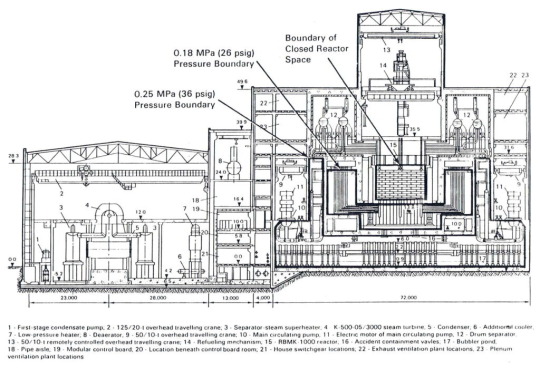
Adding to the problem of the scale of the search area was the fact that the building was potentially unstable due to the explosion of the fourth reactor. Rubble filled hallways and walls and ceilings sagged dangerously. Radiation levels fluctuated wildly within the building, with some areas almost entirely safe and others able to cause sickness and death in minutes. Even more pressing was that starting in the spring of 1986, the lower levels of the fourth unit began to slowly fill with fresh concrete. The Ministry of Medium Machine Building unit US-605, who were building the Sarcophagus to cover the radioactive remains of the unit, poured concrete into the structures of the Sarcophagus 24 hours a day. However, huge gaps and sinkholes existed in their work area, and a good portion of the concrete pumped into the Sarcophagus ended up deep in the lower levels of the block. This concrete blocked hallways, doors, and even (as they would later come to learn) covered up some of the melted fuel.
It was not until late spring of 1986 that exploration of the fourth unit block began. In June of 1986, two men were probing a steam distribution corridor in the southeast corner of the block from another corridor just below it using a powerful dosimeter which could detect radiation levels of up to 3,000 roentgens per hour. Since radiation levels in the stairway up to the corridor they were probing were already quite high (~25 roentgens per hour) they decided to send the detection head of the device up the stairs ahead of them via an assembly of metal rods. As soon as the device entered the corridor above, it went off the scale and burnt out. From this result the team was able to pinpoint a source of extreme gamma radiation.
In December of 1986, and expedition was mounted to room 217/2 to make visual contact with the suspected fuel concentration. Moving along the steam corridor this time, the team spotted a large metallic gray mass sitting neatly within the corner of the room. This formation was dubbed the "Elephant's Foot" (though some source translate it as"Elephant's Leg") due to its similarity to the leg of an elephant. The black glassy mass emitted over 8,000 roentgen an hour, deadly after just one and a half minutes (this is the maximum recorded emission, the levels would decrease significantly in the months after the disaster). For the first time, the theory of fuel lava was visually confirmed. The team branded the materiel "lava-like fuel containing masses" (LFCM).
Below: A picture of the Elephant's Foot from the direction which it was first observed. The railings just behind the main formation (Label 1) is the railing around the metal stairs from which the formation was first detected via dosimeter. Note the streaks of fuel above the formation showing where the fuel had dripped down from above. Label 4 denotes the "fresh" concrete that made its way into the building during the construction of the Sarcophagus.

Below: a view of room 217/2 from above. The red is the Elephant’s Foot, the orange is the fresh concrete, and the gray are the walls of the block. The Foot itself is the accumulation closest to the bottom left of the photograph. You can see there is more lava in an unnamed formation next to it.

After locating the fuel and taking some pictures, the team was tasked with analyzing what the lava was composed of. This may seem kind of obvious, but really it was not known what was in the LFCM. Presumably the fuel of course, but what else? It had been debated from the early days of the accident if the efforts to douse the fire and melting fuel with lead, boron, and sand had been effective (I refer here to the April 26th-May 12th aerial bombardment campaign of the reactor via helicopter- I will make a post on this effort at a later time and link it here). The contents of the fuel is an interesting topic which I will not go over more in this post. You can find more info on the quest to get a piece of the LFCM here.
After procuring a sample, one issue remained. They had found some of the fuel, but nowhere near the total amount. The grand majority of the fuel had yet to be located. By the summer of 1987 the fresh concrete that had run into the lower levels of the block began to cause real obstacles to the scientists. Many rooms suspected to contain fuel were inaccessible or could not be reached safely. A new approach was needed.
At the end of 1987 the Kurchatov team was reassigned to be part of the adventurously named Chernobyl Complex Expedition (CCE), an enormous liquidation effort that was tasked with exploring the interior of the Sarcophagus and locating the rest of the fuel in the years after the disaster. The CCE was composed to representatives from all the major Soviet scientific institutions, as well as builders and engineers. At its peak over 3,000 people worked as part of the Expedition. Through it all, the main core of this group was the scientists from the Kurchatov Institute.
Backed by resources of the entire CCE, the scientific team sought new approaches for searching for the fuel. After extensive discussion, the scientists came up with a rather ingenious solution. They would use coring drills like those used in oil drilling exploration set up in specially decontaminated rooms in the fourth unit block to drill so called ‘wells’ into inaccessible rooms. Through these they would send specially built monitoring equipment. These included thermometers, periscopes, and radiation sensors. Not only could they monitor the LFCM with this equipment, they could also obtain information about the building and the LFCM via analysis of the cores made by the drill. This allowed them to remotely locate, monitor, and sample the LFCM with minimal risk to personnel.
Below: A schematic of the wells drilled at the 9 meter mark below the reactor containment vessel. The purple lines are the wells themselves, with the gray being the concrete walls of the block. The large blue cross is the metal support Scheme S. I provided this as an example of how the wells were drilled and laid out. For more info, feel free to contact me.

Below: a member of the CCE operates a drill in the bowels of the fourth unit block. Note the protective clothing he is wearing to prevent the spread of airborne radiological contamination.

Between 1988 and 1992 a total of 134 wells were drilled between the 9 and 16 meter marks (the method by which levels of the plant are identified) and at the 20, 21, and 25 meter marks. It was eventually determined that over 180 of the 190 tons of fuel remained in the reactor block. The missing ten tons had either been blown out of the active zone and into the area around the reactor by the explosion, or had vaporized into the radioactive column that had emerged from the reactor in 1986. The remaining fuel within the block took the form of the LFCM, as well as dust. The dust created by the fuel is the main radiological enemy post 1986 and continues to be an issue to this day. Primarily composed of plutonium, the dust has thankfully remains mostly within the Sarcophagus. The LFCM, initially almost indestructible, has started to crumble and decay. As time goes on this creates even more dust, and the formations slowly erode away. This has contributed to a significant drop in gamma radiation emissions from the fuel masses and allowed for further study of the premises of the fourth unit block.
In 1994, the Complex Expedition used data collected from these wells to compile an official report on the status of the fourth unit block. With their findings published (and the Soviet Union dissolved) the CCE disbanded. Many of the scientists who worked on the expedition (and even some who were on the original Kurchatov Institute team) continued to work at Chernobyl for years. Expeditions are still sometimes mounted into the Sarcophagus, but they have not been carried out with any regularity since the early 2000s. However, visual inspection remains the only way to accurately monitor the condition of the LFCM.
You may be left wondering: how exactly did these men navigate such a radioactive environment without adverse effects? Once again I shall make a post on this in the future, but the main answer is: speed! Defense against radiation (with some exceptions) is as simple as not lingering in high radiation areas. To facilitate safe movement through the block, the scientists located and marked safe areas of reduced radiation levels (such as the room in this post) as well as dangerous areas to avoid. In the end, only a select few “Stalkers” actually set foot within the ruins of Reactor 4.
This post serves as the (admittedly lose) historical context for the exploration of the fourth unit block and the location of the LFCM. I will be making another post about the fuel rest of the fuel soon. I always feel bad for the other fuel formations because the Elephants Foot gets all of the attention. This will be a lot more technical, with locations and diagrams (joy of joys!) of the fuel as well as more context to its identification.
#chernobyl#elephants foot#radiation#history#autism#nuclear#nuclear power#reactor#china syndrome#chernobyl complex expedition#accidents and disasters#kurchatov institute#LFCM#chnpp#soviet union
91 notes
·
View notes
Text

Okay so I was reading the Wikipedia page on the Chernobyl Elephants Foot and ran into this gem. I looked into it and found that it is a true fact.
Some context for you:
The Chernobyl Elephants Foot is a big mass of Corium, concrete, and other junk that formed after the fuel rods of Reactor Four melted together into a big radioactive blob and settled in the basement below the ChNPP. Back in 1986, this thing would deliever a lethal dose of radiation in just under a minute of close proximity. The material it is mostly made of, Corium, is arguably one of the most dangerous materials on earth.
Reasearchers and scientists wanted a sample of it to figure out its true composition. They tried some conventional methods, such as a remotely controlled drill, but none of those attempts worked for various reasons. So, what do a bunch of Soviet scientists do when something just won't break? They pull out a gun.
They literally sent in a man to shoot it. They looked at this incredibly dangerous thing with the power to kill a man in under a minute, and said "Ah yes, gun."
AND IT WORKED! The AK-47 broke off a chunk of it. Theres still a mark on it from being shot as well.
TLDR: Researchers were struggling to get a sample of a very dangerous and radioactive object called the "Chernobyl Elephants Foot," so they shot it with an AK-47 using armor-piercing rounds and it worked.
(also ChNPP means Chernobyl Nuclear Power Plant)
145 notes
·
View notes
Text
We're on the outskirts of the ChNPP, I can see the anomalous distortions all built up around Reactor 4, it honestly looks like it's glowing.
Kateryna told me to give her my pistol, she cleaned it up since she actually cares about weapons, she also gave me a shotgun since "your pistol only takes you so far." She got me to shoot a bottle to try out the shotgun and I nearly dropped the damn thing, but I'm getting more used to it.
I've heard rumours of this particular aretfact that I need to find, I've heard it is inside the Sarcophagus, which is our destination.
If I can find this artefact, my life will massively improve.
Wish me luck, friends.
#s.t.a.l.k.e.r anomaly#stalker call of pripyat#roleplay#s.t.a.l.k.e.r.#stalker clear sky#сталкер#writing#oc
4 notes
·
View notes
Text
Первая послеаварийная зима в Припяти. /The first post-accident winter in Pripyat. #Чернобыль #Припять #ЧЗО #ЧАЭС #ChNPP #Chernobyl #Pripyat

2 notes
·
View notes
Text
Photo published by ChNPP in honor of the liberation of Kherson

#support ukraine#war in ukraine#ukraine#chernobyl#nuclear power plant#watermelon is the unofficial symbol of Kherson#just in case you were confused (I was)
3 notes
·
View notes
Text
Nuclear blackmail and provocations at the NPP: Moscow has not learned the Chernobyl lessons
The accident at the Chornobyl (Chernobyl) nuclear power plant (ChNPP), which occurred on April 26, 1986, is one of the largest man-made disasters in the history of mankind. It not only negatively affe Source : spravdi.gov.ua/en/nuclea…
0 notes
Text
@MayaPosch
In order to properly assess the advantages/disadvantages of sabotaging the ZNPP, we have to understand what this could actually mean. Most people seem to picture some kind of Chornobyl-like scenario, with the containment-less core burning for days due to the graphite moderator having caught on fire. This sent a hot plume of radioactive material into the atmosphere that then travelled across Europe. This is however not what happened at Fukushima Daiichi. Why? Because they're totally different reactor designs (Gen I graphite-moderated RBMK with 'cost saving measures' vs Gen II US-designed LWR), and the biggest issue at FDNPP was the hydrogen explosion in the spent fuel pools because TEPCO hadn't installed the hydrogen vents.
So, what happens if ZNPP is rigged up to the hilt with explosives, inside every accessible area? The spent fuel pools would naturally scatter chunks of the ceramic fuel around, but because they're quite heavy (think depleted uranium-heavy), they don't travel very far. For the reactors themselves, pulverising the containment structure and pressure vessel would take a lot of force, more than the fully loaded 747 falling on top of the reactor building scenario that it is designed for.
Reasonable conclusion is that at most ZNPP could be turned into a lousy dirty bomb that'd be annoying to decontaminate (scooping up top soil like around Fukushima Daiichi), but the worst part is that any sabotaging effort would likely render the reactors at ZNPP inoperable. This means the loss of 6+ GW of electrical power plus the heat (for e.g. Enerhodar's district heating system), which would make life much harder for Ukraine in the coming winters.
The fortunate thing about modern NPPs (like the VVER-1000/320 type at ZNPP) is that they are essentially impossible to weaponise (by design) unlike say an HPP or regular dam. They are however critical infrastructure, the loss of which could have devastating effects regardless. Constructing new NPPs would take 5-6 years, during which Ukraine would have to find an alternative to the loss of power and heat.
This would seem to be a perfect 'scorched earth' scenario, but the amount of condemnation would also be immense. Even if the peanut gallery (within a nuclear physics theatre) doesn't quite get the details, they do grasp that 'destroy nuclear plant is bad', and since they have collectively decided that every NPP disaster equals ChNPP #4's destruction, they're far more prepared to lean heavily into retaliatory measures, to the point of invoking NATO Article 5, as has been indicated.
Especially that latter point I think would make it seem rather... ill-advised for Putin to sabotage the plant in any meaningful manner (beyond e.g. destroying the reactors by purging them with corrosive fluids, but that's a big task in itself). Of course, this is geopolitics, which means that reason is the first thing to fly out of the window, even before the first Russian oligarch.
1 note
·
View note
Text
Russian Defence Ministry forecasts consequences of accident at Zaporizhzhya nuclear power plant
Russian Defence Ministry forecasts consequences of accident at Zaporizhzhya nuclear power plant
The actions of the Ukrainian Armed Forces at the Zaporizhzhya nuclear power plant may result in a situation similar to the one that led to the Chernobyl nuclear power plant (ChNPP) disaster, the Russian Defence Ministry has said.
The ministry recalled that despite the different nature of the events that preceded the Chernobyl and Fukushima accidents, the fundamental cause was the failure of…
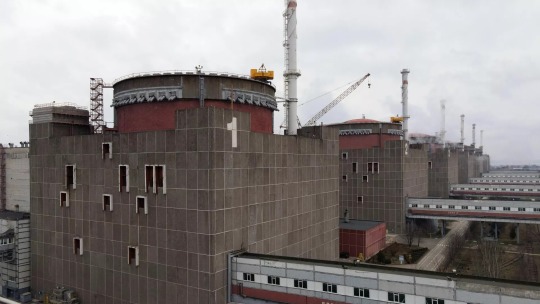
View On WordPress
1 note
·
View note
Video
Ликвидаторы/ Chernobyl Liquidator (Albin Merle) #chernobyl #ukraine #ussr #pripyat #chnpp #radiation #чернобыль #украина #ссср #радиация #припять #чаэс (at Czarnobylska Elektrownia Atomowa - ЧАЭС) https://www.instagram.com/p/CAAqO0DnEuc/?igshid=1qql1izsl5xba
9 notes
·
View notes
Text

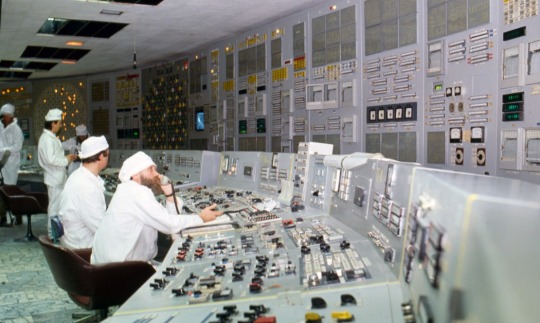


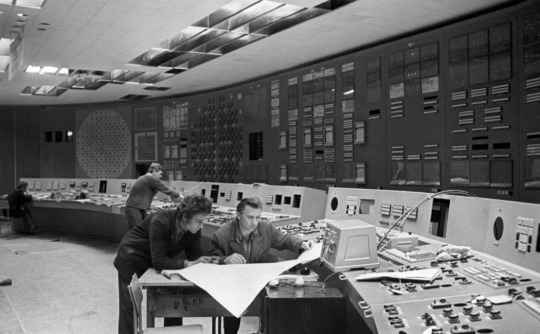

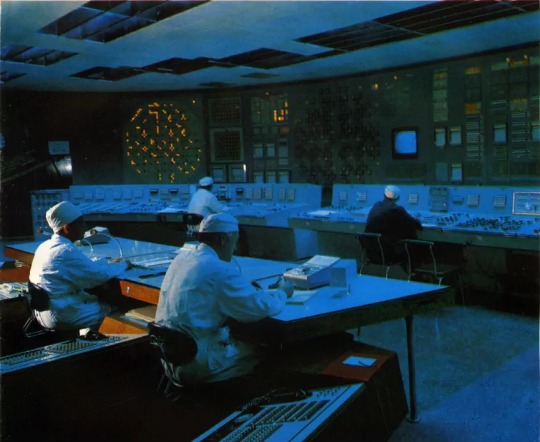


The divine interiors of the Chernobyl NPP Control Rooms #2
#*dramatic sigh*#nobody understands my vision... and obsession...#file: special interest: chernobyl#chernobyl#26th april 1986#nuclear disaster#chnpp#nuclear power plant#soviet union#pripyat#chornobyl#чернобыль
18 notes
·
View notes
Text
Principles of the RBMK Reactor

The RBMK-1000 Boiling Water Reactor is a Soviet-designed nuclear reactor capable of generating 1,000 megawatts of electricity. The core of the reactor is a short, wide cylinder. The active zone is contained inside a large metal drum, known as the core shroud. The reactor assembly is supported by a large metal disk known as the Lower Biological Shield. This sits on top of a larger metal cross labeled “Structure S”. On top of all this rests the 2,000 ton Upper Biological Shield of the reactor, known as "Structure E". The reactor sits in a large reinforced concrete shell which provides structural support and shields plant personnel from radiation.
The core region of the reactor is a large pile of graphite 14.52m × 9.7m. This pile is composed of graphite blocks 25cm by 25cm, with a height of between 20 and 60cm depending on its location in the reactor. Drilled through these blocks is a 11.4cm diameter hole, through which a zirconium alloy tube (known as a ‘technological channel’) is inserted. These contain either a fuel assembly, a control rod, or reactor monitoring equipment. These channels can be opened in situ or removed completely to replace any fuel or equipment inside them. Zirconium is used due to its high melting point and because it allows the neurons that produce the fission reaction in the core to pass through it far easier than other alloys such as stainless steel.
These metal technological channels have water pumped into them from the bottom by the Main Circulation Pumps. The entire reactor vessel is pressurized with a helium-nitrogen mixture, to prevent the oxidization of the graphite. Graphite is flammable in oxygen, but removed from it it can become quite an efficient thermodynamic conductor.
Below: A photo of RBMK technological channels at Chernobyl Unit 2. The length of these gives a good idea as to how massive the core of the RBMK is.
This picture is a screencap from this video.
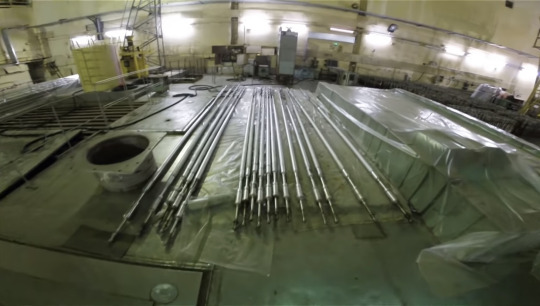
The fuel of an RBMK is small uranium oxide pellets, stacked into small metal pipes and bundled together into fuel assemblies. Uranium oxide is a ceramic material composed of Uranium 235. This element, under special conditions, can create a nuclear chain reaction which generates heat. The RBMK has three primary components that help create these special conditions to create the controlled fission reactions in the core. These are graphite, water, and boron.
Graphite is used in the core of an RBMK as a moderator. Basically, it slows down the neutrons discarded by U-236 atoms (a U 235 atom which a neutron has collided with) when they split apart. When they are released they are travelling at a tremendous speed, and have very little chance of coming into contact with another atom of uranium. Slowing them down, however, creates a higher chance of the neutrons coming into contact with an atom of U-235, creating the unstable U-236 and then pulling itself apart, thereby creating more neutrons (as well as several other elements) and sustaining a nuclear chain reaction. This sustained reaction is what creates the heat in the core of a nuclear reactor. The more neutrons there are in the core, the more reactivity (and therefore heat) is created. It should be noted that graphite is combustible at high temperatures. The core contained 1,700 tons of graphite.
Water in the core of an RBMK serves as a coolant. Because the core of a nuclear reactor gets extremely hot, it becomes necessary to cool its components if you wish to avoid destructive melting within the core region. Water is the most common coolant in nuclear reactors, as it is cheap and abundant. The water is pumped in under high pressure at about 265 C by the Main Circulation Pumps from the bottom of the reactor up into the technological channels containing the fuel and other components of the reactor. After passing through the channels and heating up to about 284 C, the water is piped out of the top of the reactor. Some of the coolant water heats up so much that it forms into steam bubbles inside the reactor. When the water is pumped out of the core it is then sent into four steam separator drums, where the steam is separated from the water. The water is then pumped back into the reactor, while the steam is sent to the turbine generators of the plant to create electricity. After this, the steam is condensed back into water using cool water from the plant cooling pond and recirculated into the cooling system.
Below: A model showing the circulation system of an RBMK-1000 reactor. Coolant water is in blue and hot water/steam is in red. The yellow structures are the main cooling pumps, and the green structures are steam turbines. This model is spatially to scale, essentially what you would see if you removed every part of the reactor except for the coolant circuit.
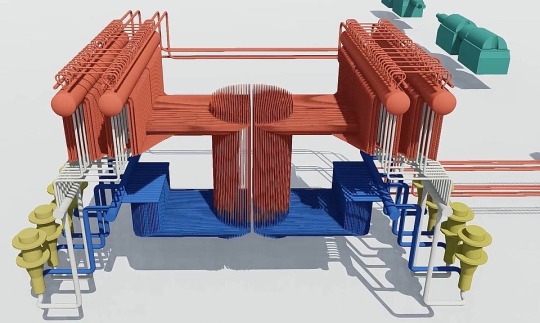
Some of the channels in the RBMK contain control rods (large boron carbide rods) that move up and down in the channel as necessary to keep the reactor within operational limits. Boron is a neutron sponge. It absorbs neutrons and can effectively eliminate a chain reaction. It functions as the brakes on a human made nuclear reaction, useful both in making sure a chain reaction does not become a runaway criticality and also in being the off switch on a nuclear reactor. The RBMK has 211 of these control rods, some of which are under operator control and some of which are under the control of a computer. A design quirk of the RBMK is that at the end of each standard control rod was a 14ft 9in graphite displacer. When a control rod was withdrawn out of the core it left behind a space that would be filled with water, a neutron absorber. Since more water in the core would kill reactivity, the designers of the reactor hung this displacer from the control rods to replace the space left by the control rod with something that would increase reactivity rather than kill it. This was a sound design choice, but it was a major factor in the events of the accident at Chernobyl.
Below: An illustration of the control rod displacers in an RBMK.
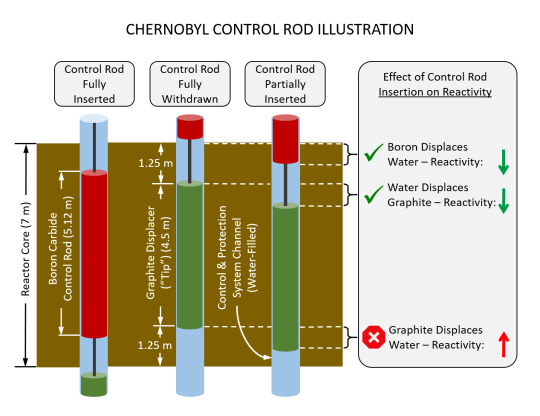
Below: A top down view of the channels of an RBMK. You can see the layout of the control rods (green), neutron detectors (blue), shortened control rods inserted from below the reactor (yellow), automatic control rods (red), and the fuel channels (grey). The number on the green, yellow, and red squares are the last recorded insertion depths of control rods in Chernobyl Unit 4 1m 30s before the explosion. Only one is fully inserted.

Below: A cutaway of the RBMK system layout.
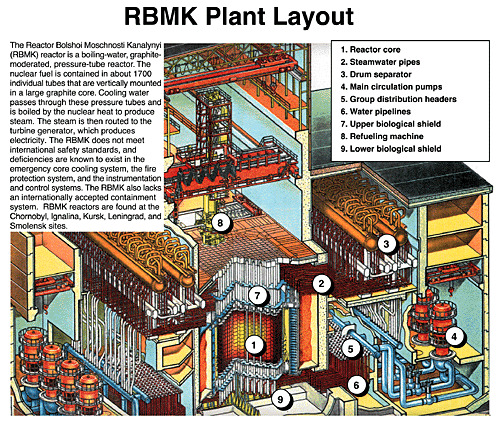
Two additional factors also come into play regarding the water. Water is naturally a neutron absorber, albeit a far less effective one than boron. The more water in the core, the less neutrons are present and therefore the lower the reactivity. However, when transformed into steam, water loses nearly all of its neutron absorbing properties. The more steam in the core, the higher reactivity is. This is called a ‘positive void coefficient’, and it was a known quirk of the RBMK and indeed several other reactor designs. However, the RBMK had a much higher level of this effect in its core due to its design. This is important to the accident sequence.
It is also important to note that the RBMK is an enormous construction. It is temperamental, unstable unless operating at full power, and requires constant monitoring and guidance from its operators. It requires three operators just to run it normally, and it was notoriously difficult to operate. The core region is so large that the equipment used to monitor it could not accurately read a large portion of it, and hotspots of reactivity would often form resulting in alarming and unexplained jumps in power output and temperature. While in theory not a bad design, the RBMK was a deeply flawed machine.
An enormous thank you is owed to @nicotinebeige , who was extremely helpful in the creation of this post. If you like film photography, you should check out their blog!
This is a technical explanation of the RBMK design. For a history of the RBMK, check out this post. Apologies for any mistakes! I’m most definitely not an expert on nuclear physics, and if anything is unclear you should absolutely check out other sources for more info. As always, thank you for your interest!
#chernobyl#nuclear reactor#history#radiation#accidents and disasters#nuclear power#autism#nuclear#reactor#chnpp#rbmk#rbmk 1000
118 notes
·
View notes
Video
We ❤️ this book trailer for new release, ‘Chernobyl: A Stalkers’ Guide,’ the newest addition to FUEL Publishing's series of books on the profound aesthetic and cultural mysteries of the Soviet world. In this case, researcher Darmon Richter goes beyond typical disaster tourist hotspots to photograph previously undocumented regions of the Chernobyl Exclusion Zone, where he once worked as a tour guide while making illegal "stalker" forays on the sly. Since the first atomic bomb was dropped, humankind has been haunted by the idea of nuclear apocalypse. That nightmare almost became reality in 1986, when an accident at the USSR’s Chernobyl Nuclear Power Plant triggered the world’s worst radiological crisis. The events of that night are well documented—but history didn’t stop there. Chernobyl, as a place, remains very much alive today. More than a quarter of a million tourists visited the Zone over the last few years, while millions more watched the acclaimed 2019 HBO mini-series Chernobyl. Richter combines photographs of discoveries made during his numerous visits to the Zone with the voices of those who witnessed history—engineers, scientists, police and evacuees. He explores evacuated regions in both Ukraine and Belarus, finding forgotten ghost towns and Soviet monuments lost deep in irradiated forests, gains exclusive access inside the most secure areas of the power plant itself, and joins the “stalkers” of Chernobyl as he sets out on a high-stakes illegal hike to the heart of the Exclusion Zone. Please order from your local independent or museum #bookstorehero @darmon.richter @fuelpublishing #chernobylastalkersguide #darmon.richter #chernobyl #pripyat #chernobylexclusionzone #ChNPP #Ukraine #urbex #postsoviet #sovietdesign https://www.instagram.com/p/CGFlsURpcd0/?igshid=1qvs98i8yjpy8
#bookstorehero#chernobylastalkersguide#darmon#chernobyl#pripyat#chernobylexclusionzone#chnpp#ukraine#urbex#postsoviet#sovietdesign
1 note
·
View note
Text
Here in the Zone, there is a (un)healthy population of slightly mutated cats, which are decendants from the remaining pets still around Pripyat and the villages near by after the 1986 ChNPP Disaster, so we usually have to spook off larger groups that are hungry enough to attack.
Interestingly, there is this one specific group which seems to have distanced itself from this one cat, I've been studing it for a while, and it seems this cat doesn't have the same level of aggression that the others do.
I've bought a few cans of tuna from Hawaiian and asked him to help me source a blanket and pillow, I'm going to try to domesticate him. I've heard rumours that some much bigger, much more dangerous mutants have been domesticated, so I have high hopes.
In other news, I've began to notice the quirks and rituals of stalkers here in the zone, how they all act and what they do interacting with each other. I've seen;
Stalkers drink vodka to combat radiation poisoning
Stalkers SMOKE cigarettes to combat raditation (Do they realise smoking causes cancer?)
There is a mythic level Stalker named "Strelok", apparently has been to the center of the zone numerous times, or atleast, from what I gather.
The Mercenaries, not our eco merc guard detatchment, apparently eat the flesh of Snorks, which are slightly mutated stalkers.
Stalkers seem like unfriendly people, considering they're all armed and very dangerous, yet they'll huddle around campfires, tell jokes, trade food and cigarettes and swap contact info. It's like an unofficial brotherhood of sorts.
Most delusionally believe in this "Wish Granter" at the Chornobyl Nuclear Power Plant that will grant any wish you have.
I've heard of other women operating in the Zone, but I haven't see any myself, doubtful if they exist.
Professor Sakharov has me tasked on a project with getting a handful of artefacts for him, a Jellyfish, an Empty and a Chain. Any stalkers who know the whereabouts of any of these or have these artefacts, swing by the lab and we'll talk.
4 notes
·
View notes
Text

It's been 33 years since Chernobyl catastrophe. The pain still lives in our hearts.
33 года прошло со дня катастрофы Чернобыльской АЭС. Боль всё ещё живет в наших сердцах.
15 notes
·
View notes
Text
is it just me who thinks chernobyl is insanely beautiful? like pryp'yat', a city that suffered through a manmade disaster and chernobyl a city that's been through endless amounts of bloodshed from nazis and purges now taken back and reclaimed by nature, the fact that it took something as horrific as two massive explosions and a reactor meltdown to bring peace to this place says a lot about the world, don't you think?
1 note
·
View note